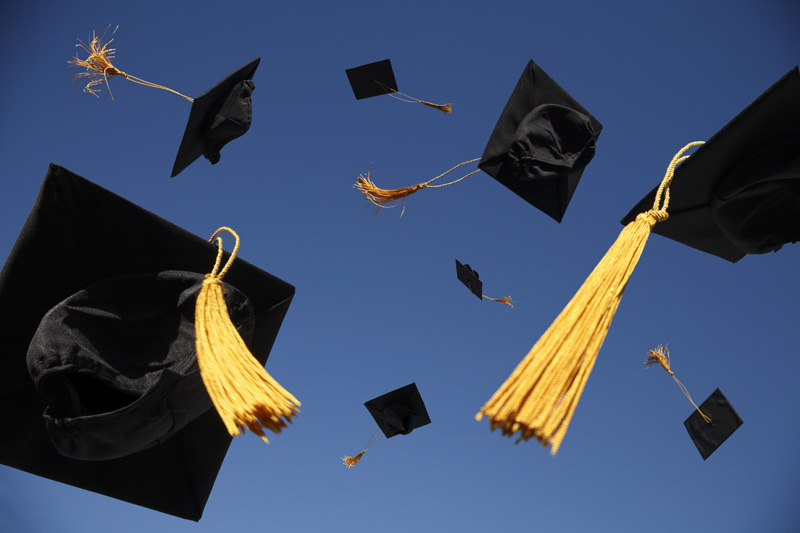
OR
Studying in the US

There is no easy or quick way to get into a US university and so there’s no such thing as a “guaranteed, easy” student visa
As we celebrate 70 years of bilateral relations between the United States and Nepal, this month we are focusing on education. We are proud that nearly 10,000 students from Nepal are currently enrolled as full-time students in colleges and universities across America. Nepal is the highest per capita source in South Asia for enrolled foreign students in the United States—surpassing India, Bangladesh, and Pakistan. When these Nepali students graduate and return home, they bring with them the vital skills needed to contribute directly to Nepal’s growth, development, and prosperity. Graduates of US colleges and universities become leaders and innovators in fields like engineering, economics, IT, journalism, education, medicine and more— exactly the kinds of qualified graduates Nepal needs for its future development.
We are proud to support improving the quality of education in Nepal—specifically in early grade reading. Our programs help improve learning outcomes and enhance opportunities for all children. By focusing on early grade reading, promoting inclusion and active parental involvement in children’s education, and strengthening government management of the education system during Nepal’s transition to a federal structure, it is our hope the pool of Nepali students who can qualify to study in the United States will grow in terms of quality, volume, and diversity.
Many Nepali students and parents wonder how the 10,000 Nepali students currently enrolled in American colleges and universities got to the United States. How did they get visas? What was their secret? I want to demystify this process because our goal is that qualified students from diverse backgrounds have an equal opportunity to seek an education in the United States if they so choose.
It’s no secret
Every year, thousands of Nepali students travel to the United States to take advantage of opportunities for educational and professional development. It takes a combination of hard work, thoughtful consideration about what course of study to pursue, careful financial planning, and an academic record that reflects good grades and test scores. And, there are many free sources of information about how to pursue these opportunities.
Where and why
If you’re thinking about pursuing higher education in the United States, ask yourself: Why do you want to study in the United States? Which colleges or universities will meet your needs? Will you need financial assistance? These are big questions, and the earlier you start answering them, the better. If you’re overwhelmed by this task, we can help. The EducationUSA office at the United States Education Foundation (USEF) hosts weekly sessions on studying in the United States and has professional academic advisors who can provide free expert guidance and help you through the process of choosing the best school for your needs. For more information on EducationUSA, visit their website: https://educationusa.state.gov/.
There’s no “free money”
Once you choose a school (or schools) to apply to, determine how you and your family will pay for your studies. US universities cost much more than those in Nepal, so you and your family need to discuss whether you can realistically afford the tuition, living expenses, and other related fees. If you’re an excellent student with a strong academic record, the best American universities offer full or partial scholarship packages. This is not “free money”—you earn it by demonstrating a record of sustained outstanding academic performance and by doing well on standardized tests like the SAT and GRE. With the right amount of planning and research, pursuing higher education in the United States can be affordable, but if you can’t pay for it, it might not be the right choice for you.
Applying to schools takes time since each institution’s application may be different, and involves collecting recommendations and transcripts, writing essays, and taking required standard examinations. Offers of admission to a US university are the result of much careful thought and hard work, both by the students who apply and by the American universities that conduct rigorous reviews of these applications.
Visa comes last
Only after you have applied for and been accepted to an accredited US institution can you apply for your student visa. Because visa interviews are often short, it is best to give concise and honest explanations about what you want to study and why you are interested in that field, how you and your family will pay for your studies, and what your plans are for when your academic program is completed. For more information on the student visa process, visit our website: https://np.usembassy.gov/visas/nonimmigrant-visas/. After you get your visa, make your travel arrangements and check your new university’s website for additional information. EducationUSA also organizes free pre-departure orientations for students getting ready to go study in the United States.
Visa consultancies: Don’t use
Visa consultancies exist to make money at your expense. They often recommend schools that do not offer scholarships or other financial aid to Nepali students. The truth is that there is no easy or quick way to get into a US university, and so there’s no such thing as a “guaranteed, easy” student visa. If someone is telling you this and charging you money, walk away.
So that’s how you do it. And while there are many talented students in Nepal, many, unfortunately, do not have the opportunity to pursue advanced studies because they aren’t obtaining the kind of educational foundation it takes to move on to higher education. While primary school enrollment rates in Nepal are nearly universal with gender parity, a vast majority of early grade students struggle to read with fluency and comprehension. Nepal needs to continue to focus on improving the quality of education and learning outcomes for all students—and particularly for girls, those from traditionally marginalized backgrounds, and students with disabilities.
Nepal’s new federal structure and the devolution of responsibilities to local governance units will require careful management, transition planning, and capacity building to ensure high quality educational services are delivered without disruption. Through our development programs, the United States is honored to support these efforts. But parents and communities will also need to be more engaged to support the transparent management and ownership of their schools. They will have the opportunity to better address the needs of the students in their locales and tailor curriculum and materials more effectively to improve learning outcomes. These types of reforms will enable future generations of Nepali students to get the high quality education that enables them to study in the United States—or wherever else they choose.
The author is American ambassador to Nepal
You May Like This

Right way to begin, yet a long way to go
“A woman is like a tea bag, you never know how strong she is until you put her in hot... Read More...

State min: Right on reproductive health to protect women's reproductive right
KATHMANDU, April 10: Minister of State for Health and Education, Padma Kumari Aryal, has said that Act related to reproductive health... Read More...

Make the right call at the right time
First of all you are only 21 years old. You have few more years to think about settling down. You... Read More...





Just In
- Nepalgunj ICP handed over to Nepal, to come into operation from May 8
- Nepal to gift two elephants to Qatar during Emir's state visit
- NUP Chair Shrestha: Resham Chaudhary, convicted in Tikapur murder case, ineligible for party membership
- Dr Ram Kantha Makaju Shrestha: A visionary leader transforming healthcare in Nepal
- Let us present practical projects, not 'wish list': PM Dahal
- President Paudel requests Emir of Qatar to initiate release of Bipin Joshi
- Emir of Qatar and President Paudel hold discussions at Sheetal Niwas
- Devi Khadka: The champion of sexual violence victims




_20240423174443.jpg)










Leave A Comment